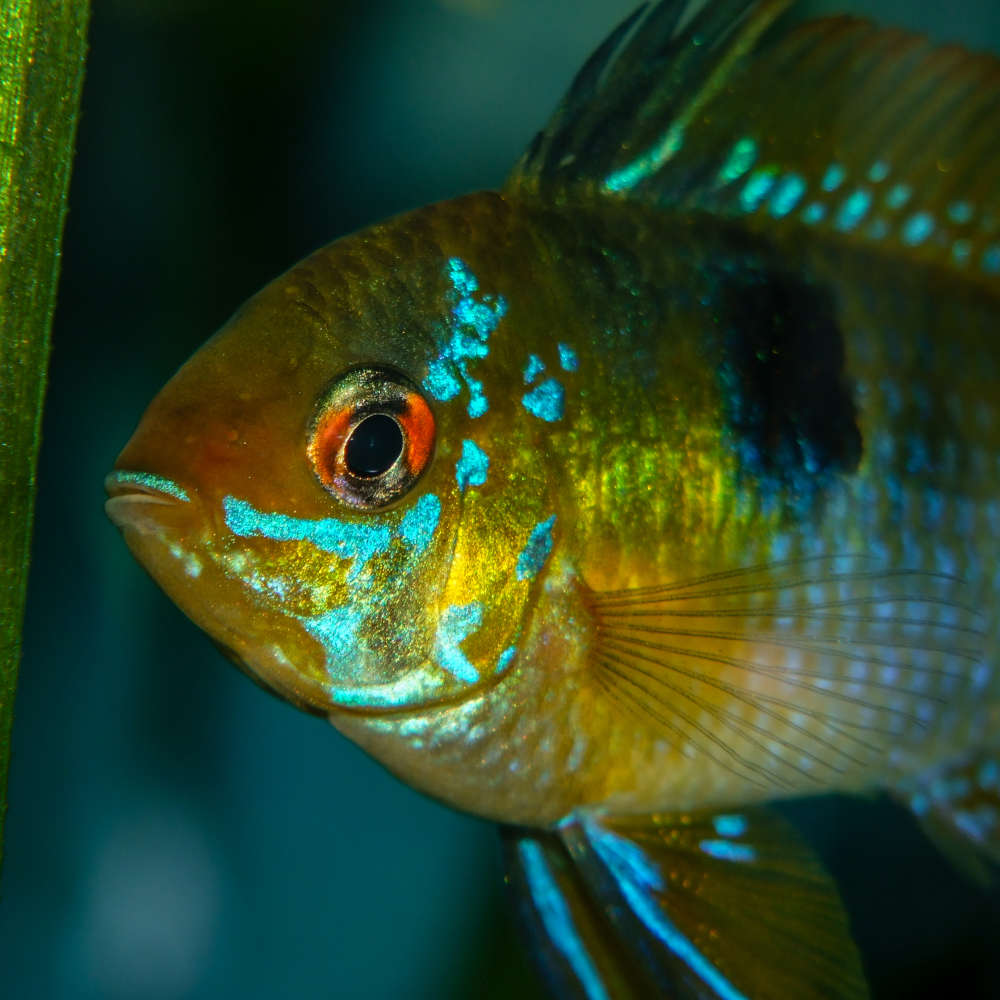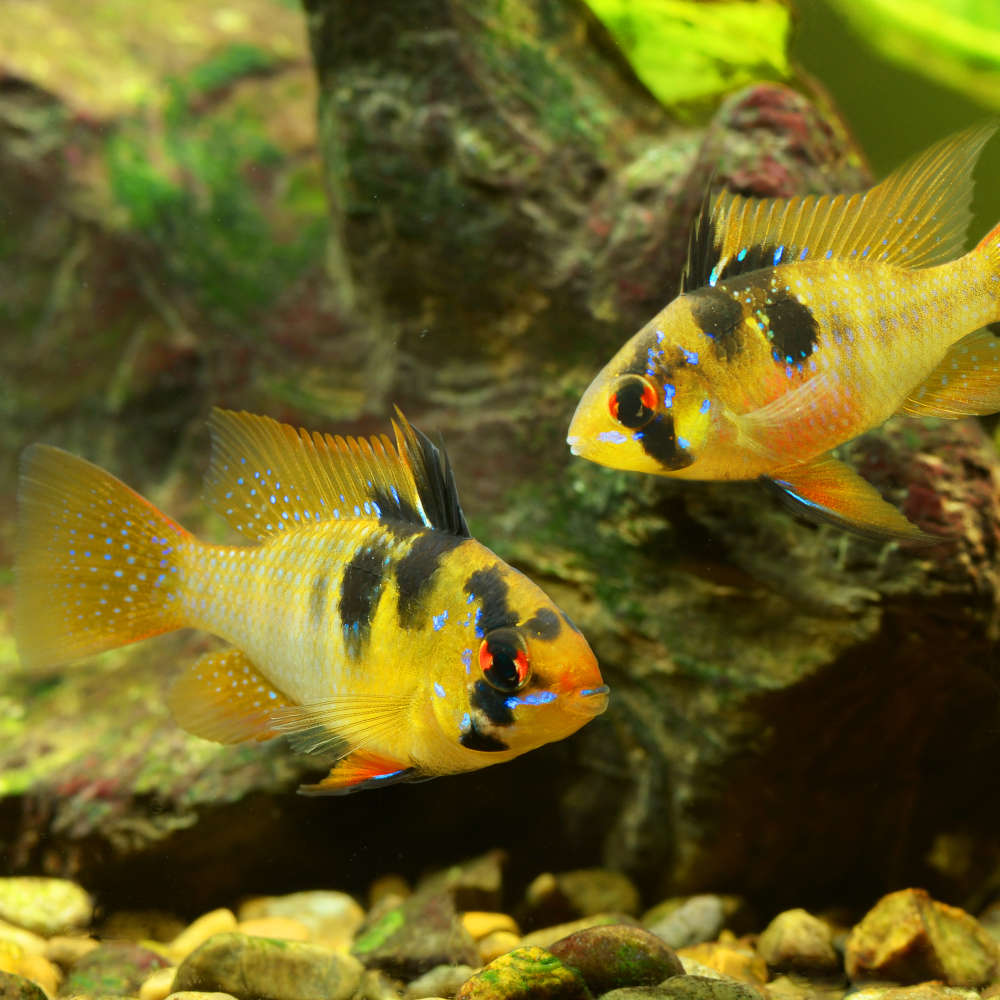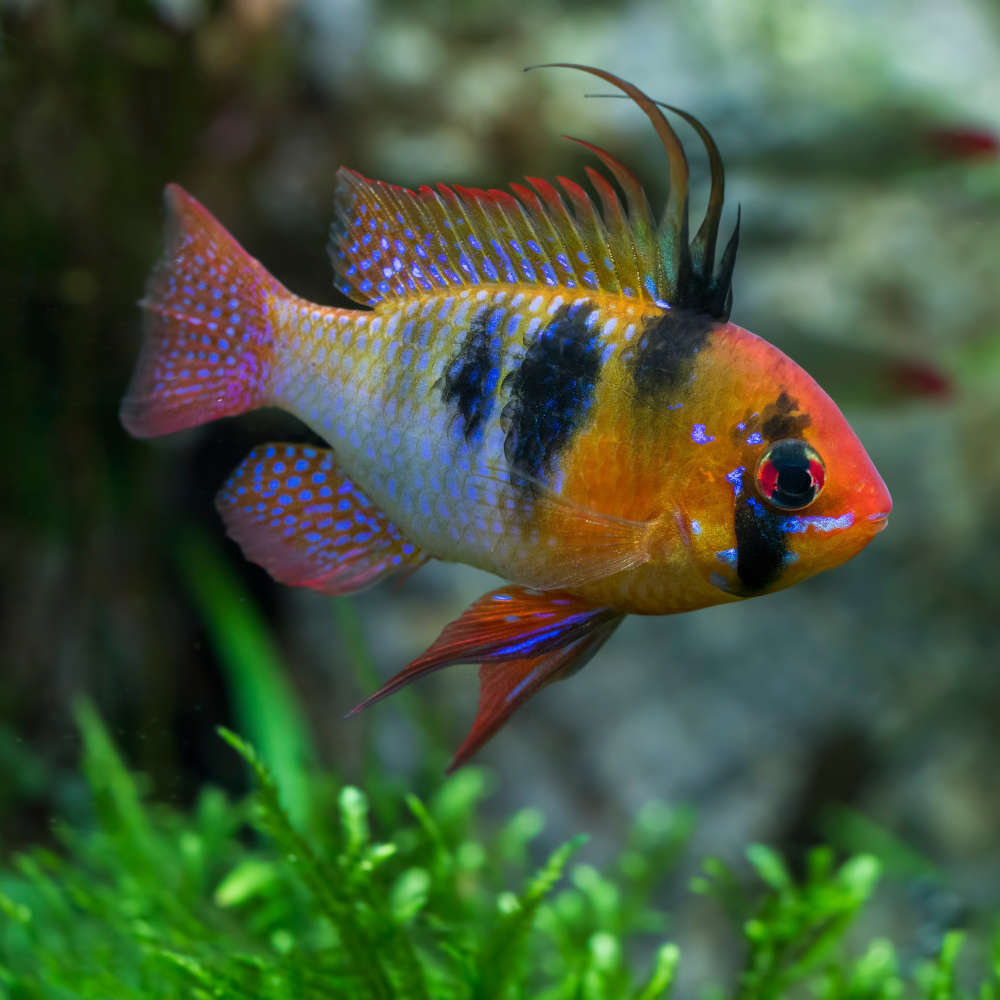If you want to add dwarf fish to your freshwater community tank of peaceful species, the German blue ram is a great choice. These are also wonderful for species-only tank and that is not to say there are tons of different German blue rams out there!
Its mellow and friendly temperament and fancy physical appearance will definitely make you swoon over it.
So, if you’re intrigued by it, let’s prepare to bring it home!
What is a German Blue Ram?
A German Blue Ram is a small size freshwater fish which belongs to the Cichlidae family.
| Origin | River Orinoco basins, Colombia and Venezuela llanos, South America |
| Order | Perciformes |
| Family | Cichlidae |
| Scientific Name | Mikrogeophagus ramirezi |
| Common Names | German blue ram, ram cichlid, dwarf cichlid, butterfly cichlid, dwarf butterfly cichlid, Asian ram, blue ram, Ramirez’s dwarf cichlid, or Ramirezi |
| IUCN Red List Status | Least Concern |
| Appearance | Ovoid body with pointy yellowish-orange fins, black marks across red eyes, bluish iridescence on body |
| Size | Around 3.5-4 cm (1.4-1.6 in) and sometimes more depending on strain |
| Lifespan | 2-3 years, 4 years with best care |
| Temperament | Usually peaceful, aggressive and territorial during mating season |
| Tank Level | Middle to bottom-level dwellers |
| Water Temperature | 81-86 °F (27-30 °C) |
| pH Level | 4.5-6.5 |
| Water Hardness | Up to 12 dGH |
| Care Level | Intermediate to Experienced |
| Minimum Tank Size | 30 gallons for two, 40 gallons for a group of 4 |
| Tank Environment | Highly vegetated, spacious tank with stained, warm, soft water |
| Diet | Mostly carnivorous but accepts omnivorous feed |
| Tank Mates | Any schooling peaceful similar-sized species |
What is the Natural Habitat of German Blue Ram?
German blue ram is native to the water courses of Venezuelan and Colombian llanos savannas in South America. More specifically, it is spotted in the Orinoco River basins and the rivers Vichada, Meta, and Morichal Largo.
You can spot the fish around slow-flowing stained waters with high vegetation. This protects the species from predators.
The IUCN Red List Status of Threatened Species labeled the fish Least Concern in their 2020 assessment.
Which family does German Blue Ram belong?
The fish belongs to the order Perciformes and family Cichlidae and is scientifically known as Mikrogeophagus ramirezi.
However, it is known by several common names worldwide: German blue ram, ram cichlid, butterfly cichlid, dwarf cichlid, dwarf butterfly cichlid, blue ram, Asian ram, Ramirez’s dwarf cichlid, or even Ramirezi.
There is a major confusion between German blue ram and ram cichlids. Well, after being exported to Germany, the ram cichlids underwent captivity breeding to produce a more vibrant and colorful species, which was named the German blue ram.
On the other hand, there are hardly any ram cichlids found in the wild. So, in most shops, when you look for ram cichlids, they assume you’re seeking a German blue ram.
Likewise, in this article, we will mainly talk about the German blue rams. So, let’s keep going!
Fun Fact: German blue rams are way more popular and in demand in the trade despite being discovered 3 decades after Bolivian rams.
How do German Blue Ram Look?

If you’re interested to know more about this species, let’s first start with looks, here!
What is the size of German Blue Ram?
The adult German blue ram usually grows around 3.4-4 cm (1.4-1.6 in). However, the specimen might grow longer if it’s a color variant or a selectively bred German blue ram.
What is the color of German Blue Ram?
Out of all ram cichlids, German blue ram is the most popular one. In fact, when you ask a seller for ram cichlids, they assume you want a German blue ram.
This has a gold or silver base body color with blue and violet accents and yellowish-orange fins. There’s a black blotch with bluish-green iridescence on the first few dorsal fins. Its head, however, shows a yellowish accent.
Black marks are present all over its head and cranial dorsal fin. It has red eyes and black spots on the dorsal side. You’ll also notice some red or orange hue on the fin edges.
However, another naturally found ram cichlid is the golden ram, scientifically called Mikrogeophagus ramirezi var. ‘Gold’.
This one is lesser-known and not as hardy. It has a yellow head, reddish-orange color on the tips of the fins and forehead, and a pale body.
But German blue rams have been selectively bred to produce various artificial color variants, namely – electric blue ram, dark knight ram, super neon blue gold, pearl/perlmutt, and many other lesser-known ones.
They have also produced varied strains like lyre-tailed, veil-tailed, long-finned, balloon, and other rams.
Despite the endless variants available, all German blue rams can be cared for in the same way.
What are the features of German Blue Ram?
The ovoid-bodied fish has pointed tails and fins. A vertical curved black line goes across both its eyes, extending from the forehead to the chin.
Like any other cichlid, it also has pharyngeal teeth in addition to regular teeth. The dorsal, anal, pectoral, and pelvic fins have a soft front part – which helps it swim – and spiny rays towards the back of these fins – which aids in protection from predators.
What is the difference between a male and a female German Blue Ram?
The adult male German blue ram is visibly bigger, more brightly colored, and has a longer dorsal fin than his female counterpart.
The female fish has a bluish tinge on the black spots on her sides. This blue coloration is absent on the male specimen.
She also sports a pink patch on her belly, unlike the male. However, this difference is only specific to wild-caught or captive-bred German blue ram and not the other ornamental strains.
What is the Behavior of German Blue Ram?
German blue ram is peaceful and shy towards other species and human beings. It only becomes aggressive and territorial during mating seasons. In fact, it even chases out species away from its nesting area during that phase.
What is the Lifespan of German Blue Ram?
German blue rams usually have a lifespan of 2-3 years only. However, in my experience, with extreme care and vigilance, you can sustain the colorful species for up to 4 years.
How to take care of German Blue Ram?

Now, if you can’t wait to get these cichlids for your aquarium, read about the steps to create a cozy home for it!
What is the Tank Size for German Blue Ram?
If you want to house a single German blue ram, a 15 or 20-gallon tank is enough. If you want to start with a mature pair, you need at least 30 gallons for them.
However, if you want to put a single or a pair of these fish in a community tank, increase the tank size considerably based on the tank mates and their needs.
A tank dedicated to German blue rams only must be a minimum of 50 gallons for a group of 4. You must upgrade if you plan to add more.
What is the Water Chemistry for German Blue Ram?
Most aquarists can’t sustain their German blue rams mainly because they can’t strictly maintain the water parameters. So, be careful about these numbers:
- pH Levels: 4.5-6.5
- Water Temperature: 81-86 °F (27-30 °C)
- Water Hardness: Up to 12 dGH
- Ammonia: 0 ppm
- Nitrite: 0 ppm
- Nitrate: Below 20 ppm
What is the Tank Environment for German Blue Ram?
Your pet fish’s health doesn’t only depend on water and space. So, pay attention to its surroundings here!
Which Substrate is needed for German Blue Ram?
Use soft sandy substrate in your tank to protect the German blue ram from nicks and cuts. You can also place a few flat, smoothened rocks as a site when the fish spontaneously spawns. Ensure that the substrate is thick enough, as the fish loves to dig pits in it.
Which Plants are required in the tank for German Blue Ram?
A highly vegetated tank will help the fish hide whenever it feels insecure. You can choose any Amazonian plant like Echinodorus, Mangrove, or Vallisneria. You can also get Anubias, Taxiphyllum, or Microsorum.
Just remember that the fish requires a high temperature in the tank, so go for plants that can survive in that range.
What is the type of Lighting required for German Blue Ram?
Use soft and dim lighting to help your pet fish feel comfortable and secure.
What is the Décor required for German Blue Ram?
The fish isn’t demanding about the decor, but add dried leaf litter and birchwood or driftwood to stain the water similar to its natural habitat. You can also add flowerpots and caves for spontaneous spawning.
What Filtration is needed for German Blue Ram?
Since the fish always needs soft water with a bare minimum TDS (ammonia, nitrite, or nitrate), you must Invest in a strong and efficient oxygenating filtration system. You must also perform 15-20% water changes every two weeks with osmosis water.
What should be the Water Flow Rate for the German Blue Ram tank?
Just like its natural habitat, make sure you maintain a slow water flow in your aquarium.
Fish Care Tip: The fish needs a biologically mature tank as a secondary food source. A newly-created (or biologically immature) tank will deteriorate its health.
What do German Blue Ram eat?
German blue ram accepts an omnivorous diet, but it loves carnivorous meals more. So, to keep it healthy and sustain its bright colors, maintain a balanced diet of live and frozen feed like the following:
- Bloodworms
- Daphnia
- Tubifex
- Artemia
- Grindal worms
- Small fish
- Shrimp
- White worms
- Cyclopeeze
- Sinking dried food
- Cichlid pellets and tablets
- Homemade gelatin-bound feed (shellfish puree, dried fish food, chopped fruits and vegetables) cut into bite-size pieces
Make sure you feed the fish twice a day. If other competitive tank mates steal its food, try to feed it by placing the food near it with tongs. You must also check that all foods are free of fungus, bacteria, or parasites.
The fish often takes mouthfuls of the substrate to find food. It then expels the sand and other inedibles through its mouth and gills.
Feeding Tip: If you have a wild-caught German blue ram, it may not accept most herbivorous feed initially. However, with time, it will get accustomed to it.
What are the Tank Mates for German Blue Ram?
You can house your German blue ram with other peaceful, similar-sized, schooling species like the following:
- Mollies
- Platies
- Guppies
- Dwarf gouramis
- Swordtails
- Cory catfish
- Bristlenose plecos
- Tetras
- Kuhli loaches
- Rasboras
- Zebra danios
- Silver dollar fish
- Clown loaches
Small schooling fish can help them feel secure and reassure them that no large or predator species are around.
However, German blue rams being carnivorous, may also eat the fry of other species. So, if you want to reproduce any of the tank mates, use a separate tank.
Which Tank Mates to Avoid for German Blue Ram?
Some people assume that German blue rams – being a type of cichlid – should be suitable for cichlid tanks. However, never house it with aggressive cichlids like
- Oscars
- Angelfish
- Convict cichlids
- Jack Dempsey cichlids
- Discus
- Flowerhorn cichlids
Similarly, you must also not put in any other large species like
- Otocinclus
- Plecostomus
- Large catfish
You must also avoid the following types of fish
- Smaller species (snails, shrimps, or any other fish that fits its mouth): They will become prey to the German blue rams
- Lively and fast-swimming fish: They will scare the rams or even nip their fins
- Species that inhabit middle and lower water levels (cory catfish): They may fight over territory.
What are the Common Diseases that German Blue Ram can have?
The German blue ram is extremely susceptible to diseases if the water parameters are unstable. Stress and external parasite introductions are also leading causes behind its sickness. So, be prepared to deal with or prevent the following diseases:
| Disease Name | Causes | Symptoms | Treatment |
|---|---|---|---|
| Fish tuberculosis/Fish handler’s disease/Fish tank granuloma | Bacterial Infection | Usually no signs Consecutive deaths of multiple fish Testing positive for fish tuberculosis | No treatment other than supportive care Prevention: Quarantine all new fish before adding in the tank. Sterilize all tank decor and thoroughly clean food |
| Hexamita/Hole in the head/Head and lateral line erosion | Parasitic Infection | Head hemorrhage, color loss, large sores and holes, red feces, mucus trailing, loss of appetite | Get antifungal treatment suitable for rams |
| Ich | Parasitic Infection | White spots, flashing, loss of appetite, lethargy | Add ich medicines for rams, raise water temperature |
| Fin rot | Bacterial Infection | Fin disintegration or fraying, fin discoloration or redness, loss of appetite, lethargy | Improve water quality, remove physically hurting objects, add medicines for rams |
| Skin flukes | Parasitic Infection | Excess mucus secretion, troubled breathing, red spots, flashing. scale loss, loss of appetite, lethargy | Improve water parameters, feed a nutritious diet, use medicines suitable for rams |
| Columnaris | Bacterial Infection | Fin fraying, grey or white spots, loss of appetite, lethargy | Improve water parameters, reduce stress, add suitable antibiotics for rams |
Quick Tip: Maintain desirable warm temperatures and keep the water soft and clear of salts and chemicals at all times. This can help them resist most health concerns and survive for the longest time.
How to breed German Blue Ram?
To breed German blue rams safely and get viable brood, you must first choose a naturally formed mated pair or buy one and then follow the given steps –
What is the Tank Preparation & Fish Conditioning for German Blue Ram?
Prepare a separate tank of 30 gallons and set the following water chemistry.
- pH Levels: 5.5-6.5
- Water Temperature: 82 °F (28 °C)
- Water Hardness: 2 dGH
Maintain extremely pristine water conditions as German blue ram eggs can easily catch fungus. Only good maintenance can help you get the best results.
You must also add flat, smoothened stones to lay eggs and flower pots to hide the fertilized eggs or hatched fry. You can also add driftwood or broad-leaved plants for egg-laying and a night light.
While the fish are still in the main tank, feed them a high-nutrition and high-protein diet. This will help them adjust to the new surroundings better.
How to Introduce Male and Female German Blue Ram?
Once you introduce the pair in the breeding tank, tape dark paper on the external surface of the aquarium. This will cut off any visual distractions and reduce stress which will further help the fish prepare for mating.
The pair will then spend a lot of time choosing and cleaning their spawning sites.
When they are ready to spawn, the female lays rows of eggs and the male then fertilizes them. The process repeats until about 150-500 eggs are laid. After mating, the pair’s body color becomes brighter, and they take turns guarding the eggs.
What is the Incubation period for German Blue Ram?
After about 60-72 hours, the eggs hatch, and the female fish move the newly hatchlings to a safer pit of choice. During this phase, the male fish may attack the female, and that’s your cue to separate the pair.
But sometimes, both parent fish might split the young fry and care for their own lot individually. But eventually, the male fish takes custody of all the fry even before they are free swimmers.
When do German Blue Ram Fry Hatch?
After 4-6 days of hatching, the young fry become free swimmers. Now the male takes the young fish in his mouth and spits them out in order to “clean” them.
Further, if a young fish gets lost from the group, the male fish sucks them in the mouth to put them back.
From this time onwards, you must sprinkle extra food for the young fish, like infusoria or microworm. You can also feed them baby brine shrimp when they are more than 7 days old.
Interesting Breeding Facts
- First-timer German blue ram parents often eat their own brood. So, patiently wait for their multiple attempts at breeding.
- Commercially produced male German blue rams are often infertile, have poor quality breeding power, and even eat their brood more often.
How to Buy German Blue Ram?
- To get the best quality German blue rams, you must only buy them from reputed private breeders. This will reduce the chances of commercial inbreeding and fish infertility.
- You must also ensure that the private breeder is local so that the water conditions of your place and theirs aren’t polar different.
- Avoid buying imported specimens as they are usually made more colorful and long-finned using hormones. This gravely impacts their lifespan.
- Always choose specimens that eat well, look healthy, swim actively, and compete with conspecifics. Avoid any thin-looking specimen.
A word from FishInAquarium
Though rams don’t need to be in groups, they literally LOVE the presence of other schooling species. And despite their meek attitude, they still stand out with their colorful appearance!
So, if this article helped you get closer to housing rams, make sure you share this with other fish hobbyists and let them join on this journey. And if you guys have any confusion, feel free to hit us up on our mail, and we’ll share our expert take on it!


